Art & Exhibitions
Here Are 7 Standout Pavilions at the 2024 Venice Biennale, From a Quirky Sculptural Orchestra to a Luscious ‘Creole Garden’
Solo shows from Egypt, Japan, and Spain are among those that made the cut.
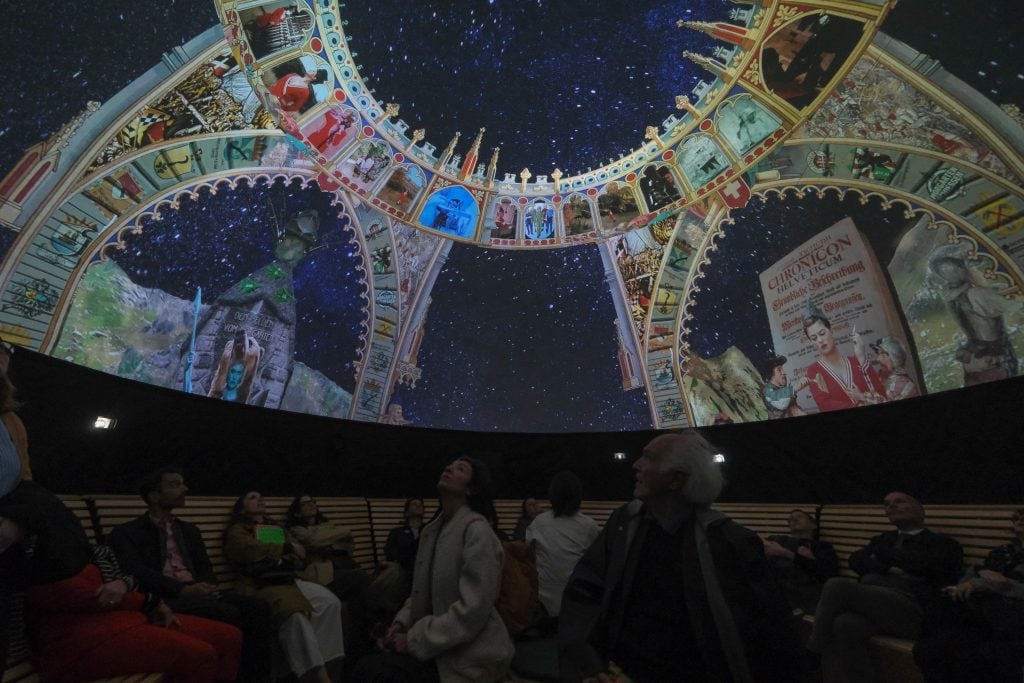
Solo shows from Egypt, Japan, and Spain are among those that made the cut.

Artnet News

It’s that time again! Art worlders have disembarked from their water taxis, taken over Venice, and walked until their feet ache in a frantic race to see the 87 national pavilions that are part of this year’s Venice Biennale. The verdicts are finally in, and curators and critics everywhere are ready to air some judgements.
There’s been more than enough to feast on. Against a backdrop of simmering political tension that included a protest in the Giardini and other sites across the city on Wednesday, many of the exhibitions complement curator Adriano Pedrosa’s main exhibition, “Foreigners Everywhere,” which spotlights Indigenous and queer artists. There is a particularly strong presence of artists from Latin America, Africa, and Asia. Among some of the most notable newcomers to the biennale are Ethiopia, which has filled Palazzo Bollani with Tesfaye Urgessa’s lively figurative paintings, Timor-Leste, and Benin.
Feeling fatigued already? If you were hoping to see some highlights and still have time for an early evening spritz don’t worry. Artnet News has narrowed down the list to just seven standouts that deserve your attention.
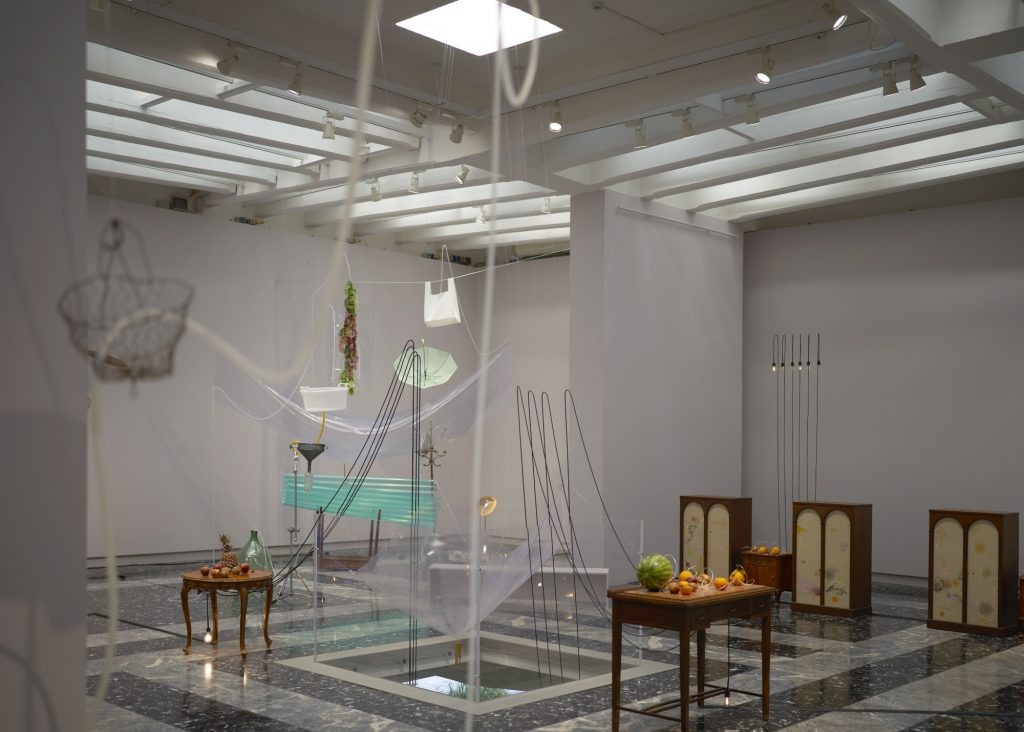
Installation view of “Yuko Mohri: Compose” for the Japan Pavilion at the 60th Venice Biennale. Photo: kugeyasuhide, courtesy of the artist, Project Fulfill Art Space, mother’s tankstation, Yutaka Kikutake Gallery, Tanya Bonakdar Gallery.
The Venice Biennale is a little like high school. Wandering around the Giardini and Arsenale, you quickly get a sense of which pavilions are the popular kids. Often, they have the slick, highly produced air of a girl who got a designer bag for her 16th birthday. In light of this dynamic, Yuko Mohri’s charming and subtle Japan Pavilion is especially refreshing. The artist created a funhouse of Rube Goldberg-like machines from everyday items, like plastic sheeting, buckets, and hoses. The display, part of an ongoing series by the artist, is inspired by the clever, improvisational ways that workers repair leaks in the Tokyo subway system. In Venice, these materials are harnessed as instruments in a quirky orchestra. A whirring fan makes a rubber tube quiver, rustling a shopping bag in turn; rain falling onto a plastic sheet jostles a set of wind chimes. Situated throughout the space are groupings of rotting fruit connected to electrodes; the fluctuating moisture content of the oranges, strawberries, and grapes is converted into synth sounds and flickering light. The installation activates all the senses and manages to do something lofty—embodying the interconnectedness of all things—with humor and verve.
–Julia Halperin

“Greenhouse” for the Portugal Pavilion at the 60th Venice Biennale. Photo: Margaret Carrigan.
A luscious “Creole garden” filled with native African flora transplanted into an elegant, oak-paneled 19th-century interior has a richly surreal quality. It made me feel like I had stumbled into one of the impeccably designed, technicolor stage sets for Yorgos Lanthimos’s Poor Things (2023), so, of course, I was immediately sold. These seductive outward appearances are impressive on their own, but a series of sound and video installations embedded throughout the foliage, as well as site-specific performance pieces, give the work a strong conceptual focus.
Taking the idea of gardening as an act of collaboration, joy, freedom, and resistance, the show is inspired by the private plots historically cultivated by enslaved people. Its authors, three women artists, curators, historians, and researchers, contrast these small biodiverse bounties of growth and hope with the extraction of monocultural crops on a plantation.
In the film Weaving, performers recount stories associated with the revolutionary activity of Bissau-Guinean anti-colonialist Amílcal Cabral, who was born 100 years ago this year and played an instrumental role in winning Guinea its independence from Portugal. A more luxuriantly abstract film, Transplanting, lingers on a group of silent dancers as they explore a densely verdant, semi-tropical landscape.
—Jo Lawson-Tancred
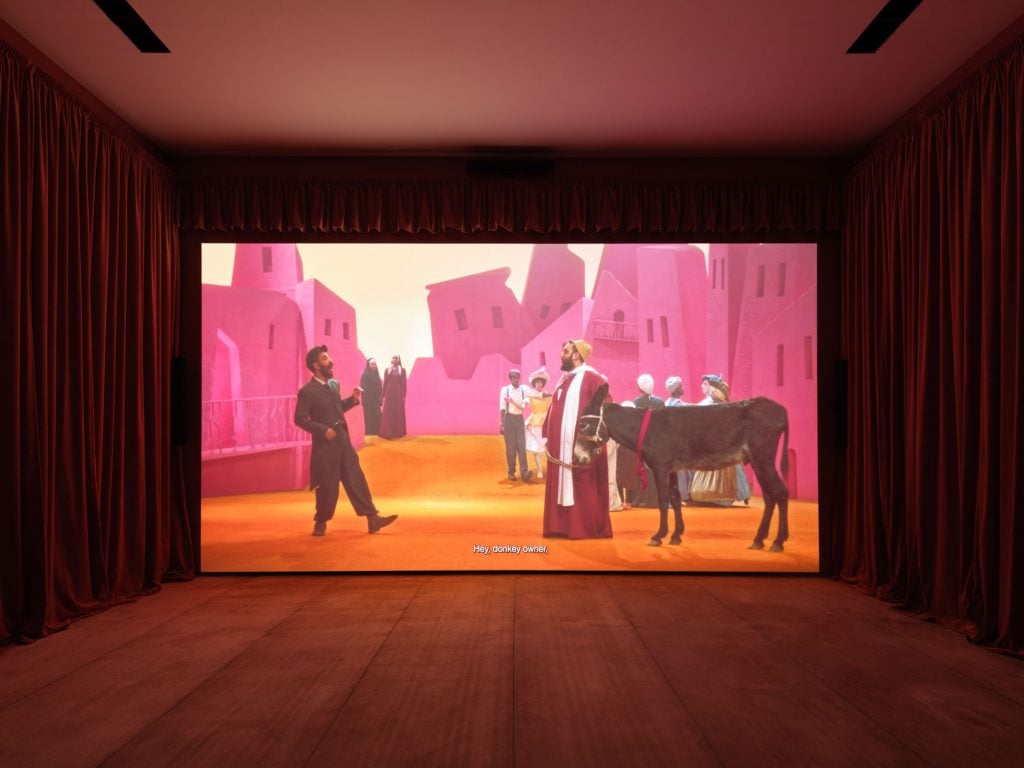
Wael Shawky, Drama, 1882 (2024). ©Wael Shawky. Courtesy of Sfeir-Semler Gallery, Lisson Gallery, Lia Rumma, and Barakat Contemporary.
Wael Shawky has brought a bold musical film to the Egyptian Pavilion. In Drama 1882, the Alexandria-born artist creates a parable confronting history’s grip on the present.
Set against the backdrop of occupation in Egypt, the film delves into the nationalist fervor of the 1879–82 Urabi Revolution. The violent peasant uprising against the Egyptian monarch’s susceptibility to imperial influence eventually backfired and became a catalyst for British rule, which lasted until 1956.
Shawky’s exquisite film, shot in a historic open-air theater in Alexandria, weaves together fact and fantasy with mesmerizing melodies sung in Classical Arabic. It is shown alongside sculptural elements from the film’s elaborate sets.
Seeing the film during this biennale, its upheaval and uncertainties echo the catastrophic events unfolding in the Middle East today. The surreal inflection opens up space for historical analysis. Through Shawky’s lens, history becomes a moving tapestry of revisionism, challenging audiences to reconsider the narratives we inherit.
—Naomi Rea
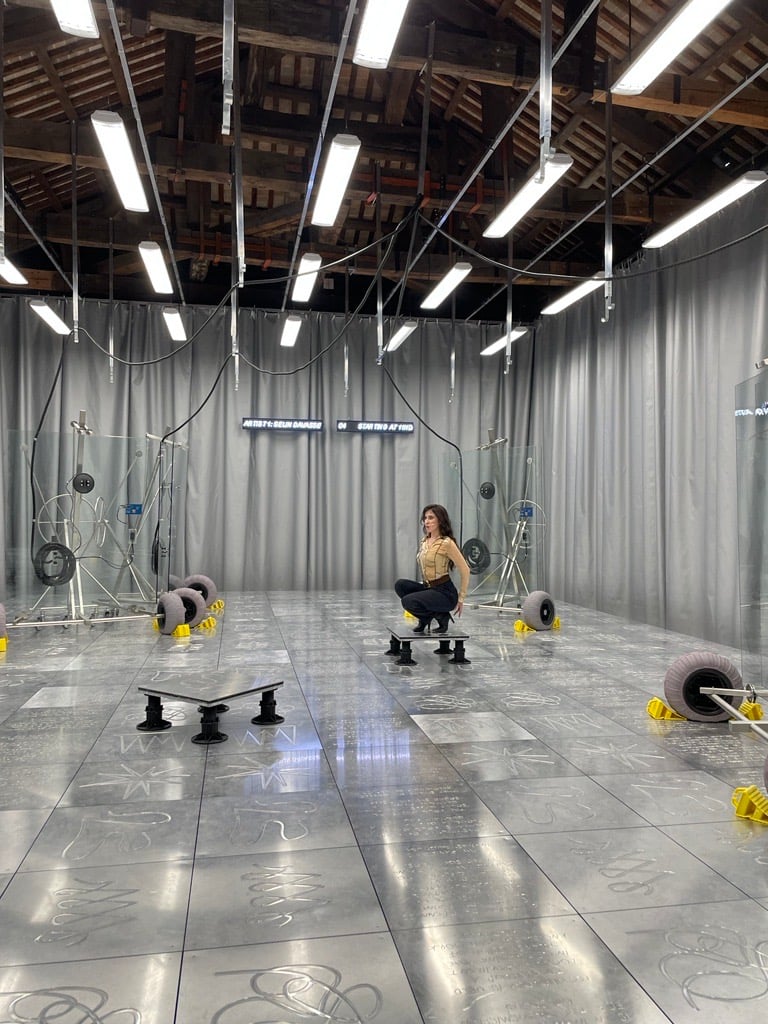
Selin Davasse performing at the Luxembourg Pavilion.
Over the years, I have come to find it hard to get down with group shows at the biennale’s national pavilions. It is perhaps a weird bias I have developed for one- or two-person shows, because as soon as more artists enter the frame, the pavilions rarely end up feeling as cohesive as they should, especially in the old stately venues that can easily feel cramped full of too many ideas. (Plus, there is the very big group show to set yourself apart from next door.)
That is why I was particularly excited to see a pavilion deliver a clever rethink of what a group show can be: in “Comparative Dialogue Act,” organized by the collective Every Island and artist and musician Andrea Mancini, the pavilion is a steel stage where sound curtains are drawn, and where performances will be layered over the next months in the form of distinct “residencies.”
It is like a group show focused on sound, where the premise is gamified, with specific instructions given to four performance artists who will take over the stage. The rules and boundaries of the performances are etched into the stage floor: aural content one artist produces during their turn at the stage can then be used and further adapted by the next artist who is up, creating a sense of collaboration but also blurring authorship by allowing for appropriation. Up first is the brilliant Selin Davasse, who deftly subverts female mythology in unsettlingly beautiful performances that are somewhere between singsong and a dark Medea-like monologue.
Whereas what we tend to see in Venice is a finished product, the Luxembourg pavilion is only beginning to be made.
—Kate Brown
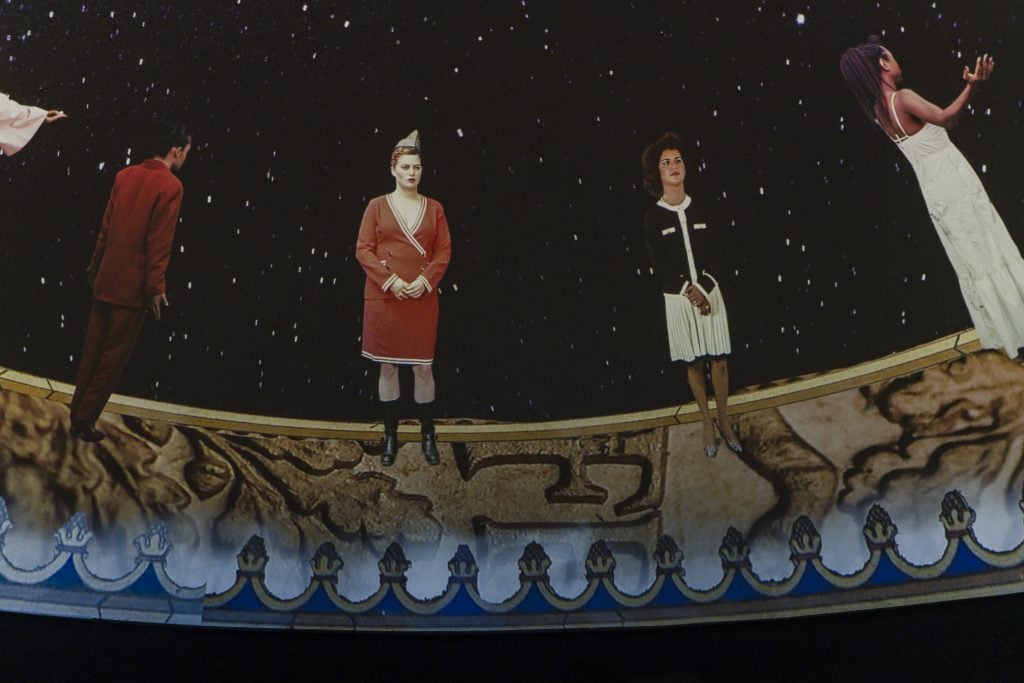
Installation view of “Super Superior Civilizations” by Guerreiro do Divino Amor at the Pavilion of Switzerland at the Biennale Arte 2024. Photo: Samuele Cherubini.
The biennale’s country-by-country pavilion structure, coupled with its title and theme this year, unleashes an expanse of somber rivulets: nationalism, jingoism, exoticism—the isms and otheredness to explore pile on. The Swiss-Brazilian artist Guerreiro do Divino Amor takes on all of these topics, but he sneaks the medicine into a surreal sensory overload of rollicking wit and daring aesthetics.
In “Super Superior Civilizations,” Divino Amor deftly melds Swiss identity (and stereotypes—plenty of clocks and cheese swirl by) with Greek mythology and his own bonkers cosmology. An installation veers from high-tech 3D-surround imagery to campy low-budget architectural ruins like collapsed columns and a fountain with a spinning head and laser eyes. It’s an impressive assemblage, but the video component, “The Miracle of Helvetia,” propels this pavilion into the stars.
Viewers can lie back and look skyward, planetarium-style, at the dome-shaped screen, as a Greek epic unfurls heavy with Swiss symbology. A pantheon of the artist’s expertly casted, just-slightly-off-kilter normcore demigoddesses coalesce like constellations. Live action blends with computer animation and graphics that at times look like they’re circa 1992. Is this an art film or a dystopian Swiss propaganda infomercial? And why did a clip from Dynasty pulse by?
At times, it’s a laugh-out-loud experience. Upon exiting, you’re hit with how visceral and thought-provoking Divino Amor’s maximalist vision is. He’s poking grand truths with a stick.
—William Van Meter
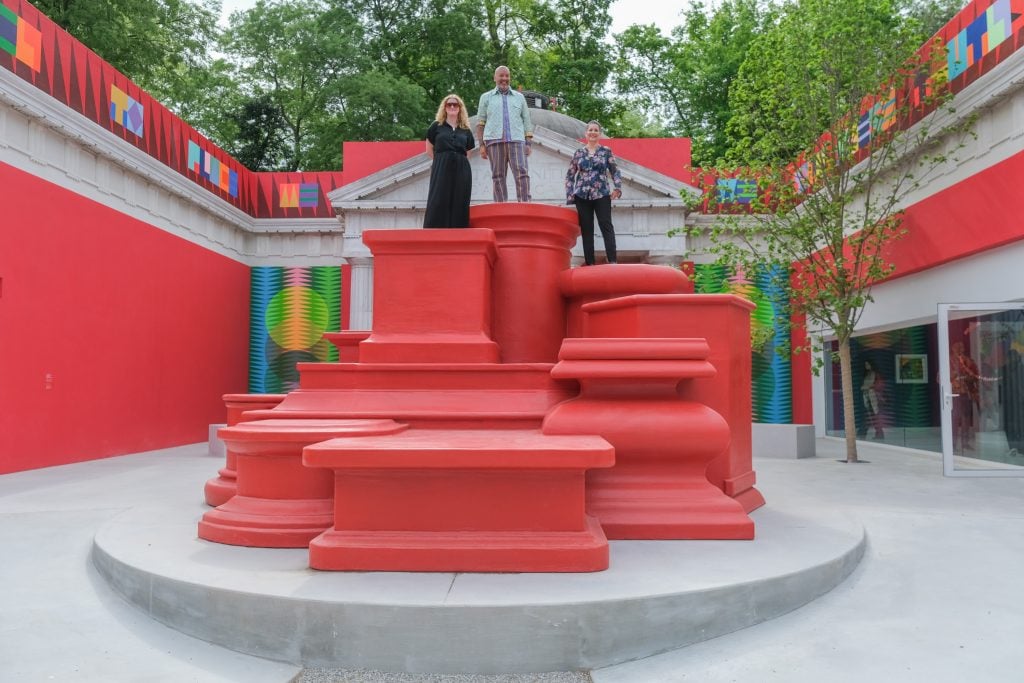
Jeffrey Gibson, center, stands with curators Abigail Winograd, left, and Kathleen Ash-Milby, right, at the entrance to the U.S. Pavilion in the Giardini during the 60th Biennale Art 2024 on April 16, 2024 in Venice, Italy. Photo: Stefano Mazzola/Getty Images.
The U.S. Pavilion is a riot of color this year, thanks to Choctaw-Cherokee artist Jeffrey Gibson, who is the first Indigenous artist to represent the nation solo at the Venice Biennale. His exhibition, titled “the space in which to place me,” is also the first to be co-commissioned and co-curated by a Native American curator, Kathleen Ash-Milby, who is the curator of Native American Art at the Portland Art Museum in Oregon and a member of the Navajo Nation.
The front of the Palladian-style building is nearly obstructed by a cluster of oversized red pedestals, all of which are empty of any historical icon. Their scale makes you feel like a kid, and visitors are invited to climb on them, which only heightens the sense of play. Throughout the interior of the building, patterned walls create an almost psychedelic effect, and a multichannel video work featuring jingle dress dancers and a banging beat had me both entranced and wanting to dance.
Gibson’s signature punching-bag sculptures, composed of vibrant silks and traditional Native beadwork, are of course included. The central work in the pavilion’s rotunda is emblazoned with an excerpt from the U.S. Declaration of Independence: “We hold these truths to be self-evident.” The next part of that infamous line, “that all men are created equal,” is omitted, and the rotunda is painted red from floor to ceiling, suggestive of the genocidal bloodshed of native peoples and their removal from their ancestral lands, facilitating the creation of the nation-state as we know it today. Just like Gibson’s color palette, the meaning is not subtle.
Still, the show feels joyous. If I am honest with you, that made me dislike it on my first visit—some of the individual works, mainly the paintings, felt superficial and disingenuous to me. But, on Wednesday, after seeing pro-Palestine protestors scramble to the top of the giant plinths out front, wave a black-and-white keffiyeh from the top pedestal, and distribute a manifesto that calls for the dismantling of nation-states, “reclaiming land,” and restoring art as a central tool of resistance, I saw the pavilion as a holistic concept. Just as the plinths out front offered a literal platform for revolutionary ideas, so too does joy amid oppression.
—Margaret Carrigan
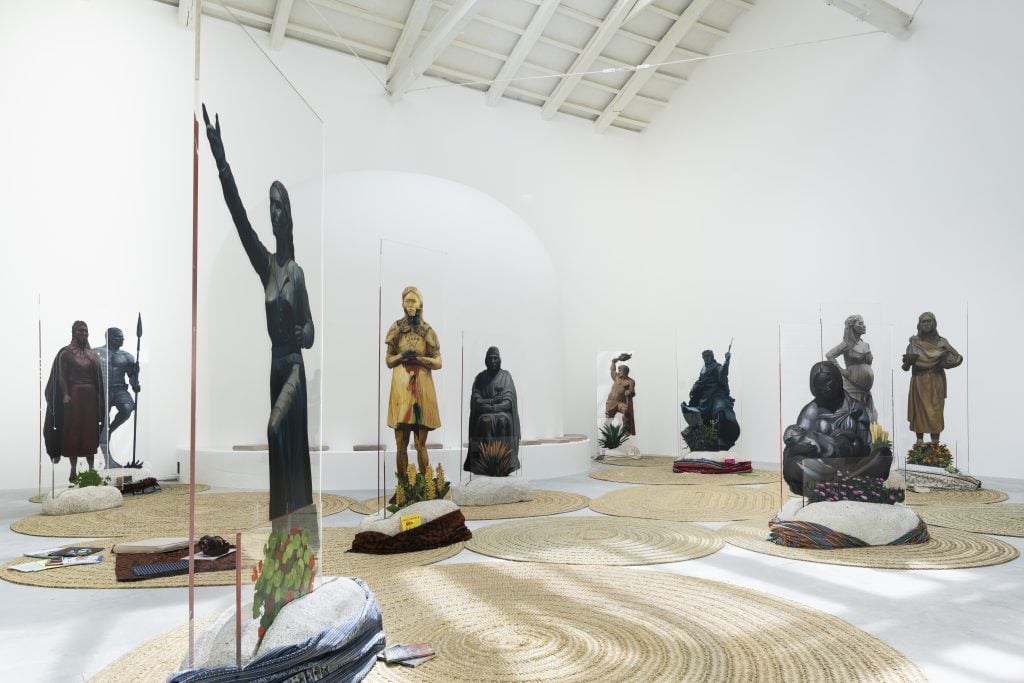
Installation image of the Spanish Pavilion, “Pinacoteca Migrante/ Migrant Art Gallery,” at the 60th International Art Exhibition of La Biennale di Venezia 2024. Photo: Oak Taylor Smith.
First, you wait in line for your turn. Then, you are given a sticker and asked to put it on, just like you normally would going to a museum as a visitor. The artist Sandra Gamarra Heshiki and curator Agustín Pérez Rubio aimed to create an institutional experience for those stopping by this year’s Spanish pavilion, which has been transformed into an elaborate museum mirroring the setting of a Western art gallery. But rather than showing Western art, “Pinacoteca Migrante / Migrant Art Gallery” puts at its center narratives of migration and colonialism that have historically been silenced in Spain and the West.
Coinciding with this year’s theme, “Foreigners Everywhere,” Gamarra Heshiki, a Peruvian artist with Japanese heritage based in Madrid, has become the first non-Spanish-born figure to represent the country at the Olympics of the art world. She has created an impressive body of work in different media—paintings, drawings, ceramic works, small sculptures, and installations of cabinets—that draws on her extensive research into artworks from the era of empire and the Enlightenment that are kept in Spanish museums. Her delicate creations expose the biased narratives of colonial histories and the invisibility of migrants, which she defines as humans, plants, other living organisms, and raw materials.
The show was strengthened by a tour by Pérez Rubio, a very articulate Valencia-born curator and art historian, who shared his own knowledge and personal experiences growing up in Spain, questioning the missing pieces and representations of the colonized in the “official” narratives that the artist explores across five exhibition rooms. Visitors then move to the “Migrant Garden” in the pavilion’s naturally lit central space, where painted copies of monuments are found. Here, visitors are encouraged to take their time to meditate on the themes of this meaningful and expansive show, and perhaps consider what can be done to make a difference in the future.
– Vivienne Chow